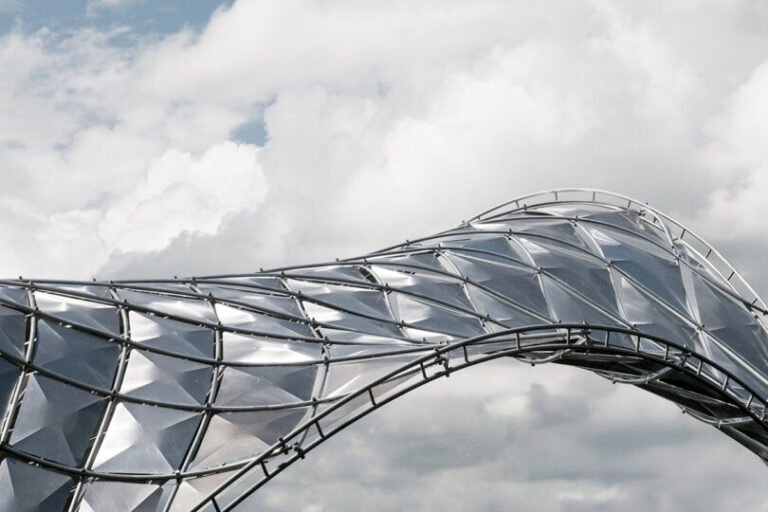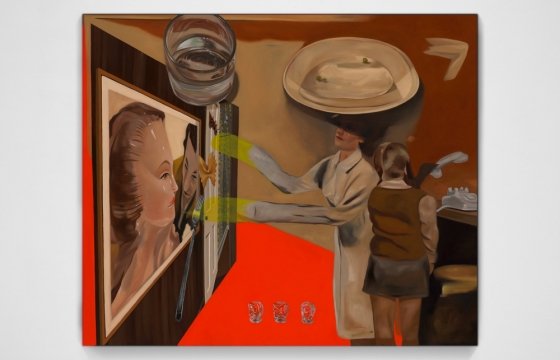

Installation by Led by Donkeys in Block 9. Image: Tom May
After experiencing muddy boots and magical moments across four decades, here’s one veteran’s honest take on the world’s biggest green-field festival.
I have been trudging through the fields of Worthy Farm, Pilton, Somerset on and off, since 1987. I’m here right now, on behalf of Creative Boom, and I still absolutely bloody love it. There, I said it.
But here’s what drives me barmy. People who haven’t been in years will tell you, with absolute certainty, that it’s not as good as it used to be. They’ll shake their heads sadly and mutter about how it’s “too commercial now” or “lost its soul” or some other nonsense, despite having zero personal evidence for that view.
Old patterns repeat
The reasons for this Glasto-hate are usually pretty transparent. There’s the (understandable) resentment towards those lucky enough to have navigated the ticket lottery. Or there’s the musical snobbery. “I don’t know any of these bands,” they’ll announce, as if the world stopped awarding cred points in 1994, and anything after that is worthless.

Shangri-La. Image: Leora Bermeister

Unfairground. Image: Tom May

Green Fields. Image: Tom May
Then finally, there are the rose-tinted spectacles that colour the things we did in our youth, when we had more energy, better skin and life was full of promise. This automatically makes them better in our minds, even if they weren’t in reality.
And this is a pattern that keeps repeating. When I first pitched up at Glastonbury in 1987, clutching my £21 ticket, the old-timers were already lamenting the festival’s decline. “You should have been here in ’83,” they’d say, shaking their heads mournfully. “That’s when it was really special.” I’m willing to bet that in 1983, people were banging on about how much better it was in ’79.
View from the Beeb
Those who’ve never been to Glastonbury, meanwhile, tend to base their view on the BBC coverage. Now, don’t get me wrong: the Beeb does a decent job, and I’m grateful people can watch Pyramid Stage headliners from their sofas. But forming a strong opinion from that is like judging London based on the view from the top of a double-decker bus. You’re missing about 96.7% of what’s actually happening.
The BBC focuses on the big stages, because that’s what translates best to TV. But the festival is enormous, sprawling across 900 acres with more stages, tents and random performance spaces than you could possibly imagine.

Unfairground. Image: Tom May

Green Fields. Image: Tom May

Shangri-La. Image: Jody Hartley
There are hundreds of tiny music stages, tucked away in a corner where someone’s doing something intimate and beautiful that would never work on a massive outdoor set. Then there’s the Theatre & Circus area where you’ll stumble upon a kaleidoscope of world-class performances, by artists from across the globe.
There’s Shangri-La, a radical playground that suggests a different way to organise the world. There’s the Left Field, where people can really dive deep into political debate. There’s the cinema, where A-list stars like Ncuti Gatwa, Andrew Garfield and Tilda Swinton introduce the films in person. There are dozens of night clubs and dance areas, playing everything from Latino classics to dirty drum & bass. Honestly, there isn’t room to list everything here: the article would be endless.
So what’s it actually like to go to Glastonbury these days? Well, it’s complicated.
The good stuff
The good stuff is still absolutely magic. There’s an energy at Glastonbury that you simply can’t replicate anywhere else; this sense of endless possibility around every corner.
You’ll be wandering between stages, trying to catch the end of one band before rushing to see another, when you’ll stumble upon something completely unexpected. Like a bunch of people trying to throw tennis balls into the mouth of an enormous frog statue. Or a massive billboard telling the personal story of a family of travellers.

Unfairground. Image: Tom May

Unfairground. Image: Tom May

Shangri-La. Image: Jody Hartley
Last night, I accidentally discovered a Ghanian musician called K.O.G at Shangri-La that I’m now completely obsessed with. Then I walked into a knot of people who spontaneously broke into a rendition of Chappell Roan’s Pink Pony Club. That’s what Glastonbury does: it throws random encounters at you constantly.
It’s all quite overwhelming. There’s always something happening somewhere, and the fear of missing out is real, but also part of the excitement. You’ll make snap decisions based on overheard conversations, follow crowds down muddy paths, and find yourself in spaces you never planned to visit. The serendipity is intoxicating.
It’s not perfect
But let’s be honest: anyone who claims Glastonbury is uniformly wonderful is either lying or on some serious drugs.
The loos become horrific, quite quickly: a special kind of hell that no amount of chemical blue can mask. I can literally smelll them from my tent as I write this, and it’s threatening to harsh my morning buzz. Walking in and using them is a matter of holding your nose and shielding your eyes. And God forbid if you forget to bring enough toilet roll.

Green Fields. Image: Tom May

Unfairground. Image: Tom May

Green Fields. Image: Tom May
The crowds can be suffocating, especially when everyone’s trying to move between the same popular stages at the same time. If you have any form of disability, you probably won’t cope. Heck, most people in general will struggle with the physical effort.
That’s not to mention the endless, deafening noise. I’m camped near Shangri-La and the thunderous bass doesn’t stop till 4am. I’ve learned to sleep through it, but I’m not sure how many others could.
As amazing as the lineup is, the stage clashes are heartbreaking. Inevitably, your two must-see acts will be playing simultaneously at opposite ends of the site. This is actually a good thing when it comes to crowd control; people have literally been crushed to death at other festivals. But it’s still a bummer trying to choose between Doechii and Charli xcx, Alanis Morissette vs Gracie Abrams vs Blossoms, Lola Young vs English Teacher vs Wet Leg…
The mud, when it comes, is legendary for good reason. It’s not just a bit damp underfoot; it’s a malevolent, sucking force that will claim your wellies and possibly your soul. I’ve seen grown adults reduced to tears trying to extract themselves from particularly treacherous patches near the main stages.
Alternatively, if the sun is strong then good luck finding any shade, or getting tap water without queuing for an age. Thankfully we’ve had the most beautiful in-between weather for 2025 so far, but don’t expect that every time.
Unchanged spirit
But the idea that this not-for-profit festival, which raises a ton for charity, is now too “commercial”? I don’t buy it. The price of tickets is very reasonable compared to the cost of a five-day holiday anywhere else. And while the involvement of the BBC has certainly made the event feel more mainstream, for the vast majority of punters the essential spirit of Glastonbury remains unchanged.
It’s still a place where weird, wonderful things happen when you least expect them. It’s still a vast temporary city built on music, creativity, and the peculiarly British ability to have a brilliant time despite unpredictable weather and questionable sanitation.

Shangri-La. Image: Alex Kurunis

Green Fields. Image: Tom May

Shangri-La. Image: Jody Hartley
The festival has evolved because the world has evolved. Music changes, audiences change and commercial realities change. But the magic, that indefinable something that makes Glastonbury special? That’s still there, as strong as ever.
To those who insist it’s not as good as it used to be, I’d say: you’re probably right about some things, and completely wrong about others. But until you’ve actually experienced it yourself, you’re really just guessing.
So for those lucky enough to score a 2027 ticket, prepare for something simultaneously wonderful and terrible; exhausting and exhilarating. Just bring loo roll, proper wellies and a positive attitude, and you won’t go far wrong.


